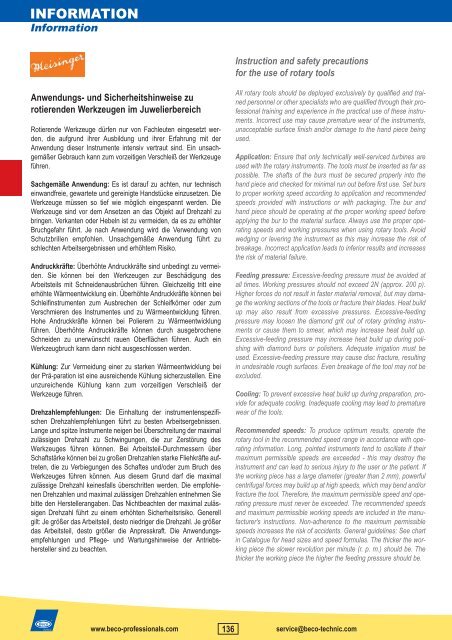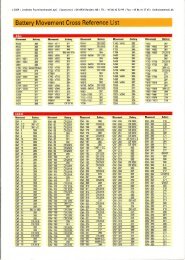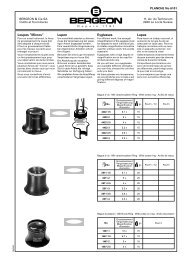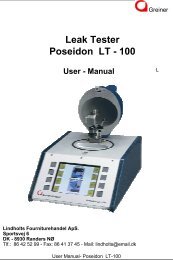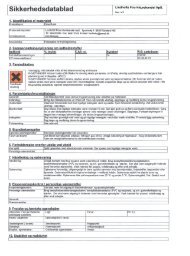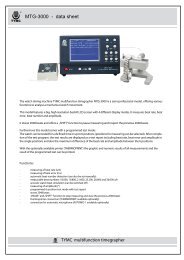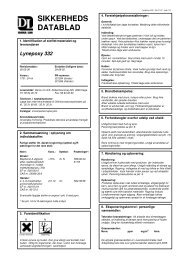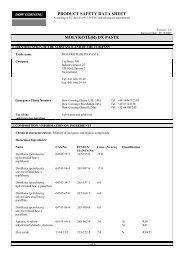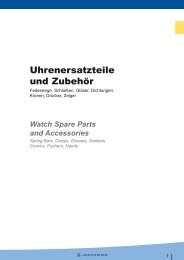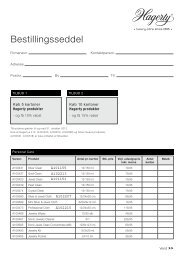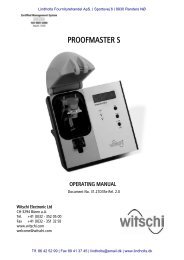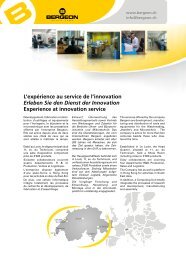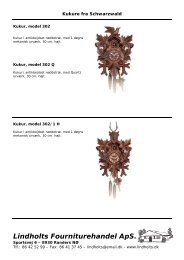Handels- und Serviceprodukte für den Verkauf
Handels- und Serviceprodukte für den Verkauf
Handels- und Serviceprodukte für den Verkauf
You also want an ePaper? Increase the reach of your titles
YUMPU automatically turns print PDFs into web optimized ePapers that Google loves.
INFORMATION<br />
Information<br />
Instruction and safety precautions<br />
for the use of rotary tools<br />
Anwendungs- <strong>und</strong> Sicherheitshinweise zu<br />
rotieren<strong>den</strong> Werkzeugen im Juwelierbereich<br />
Rotierende Werkzeuge dürfen nur von Fachleuten eingesetzt wer<strong>den</strong>,<br />
die aufgr<strong>und</strong> ihrer Ausbildung <strong>und</strong> ihrer Erfahrung mit der<br />
Anwendung dieser Instrumente intensiv vertraut sind. Ein unsachgemäßer<br />
Gebrauch kann zum vorzeitigen Verschleiß der Werkzeuge<br />
führen.<br />
Sachgemäße Anwendung: Es ist darauf zu achten, nur technisch<br />
einwandfreie, gewartete <strong>und</strong> gereinigte Handstücke einzusetzen. Die<br />
Werkzeuge müssen so tief wie möglich eingespannt wer<strong>den</strong>. Die<br />
Werkzeuge sind vor dem Ansetzen an das Objekt auf Drehzahl zu<br />
bringen. Verkanten oder Hebeln ist zu vermei<strong>den</strong>, da es zu erhöhter<br />
Bruchgefahr führt. Je nach Anwendung wird die Verwendung von<br />
Schutzbrillen empfohlen. Unsachgemäße Anwendung führt zu<br />
schlechten Arbeitsergebnissen <strong>und</strong> erhöhtem Risiko.<br />
Andruckkräfte: Überhöhte Andruckkräfte sind unbedingt zu vermei<strong>den</strong>.<br />
Sie können bei <strong>den</strong> Werkzeugen zur Beschädigung des<br />
Arbeitsteils mit Schnei<strong>den</strong>ausbrüchen führen. Gleichzeitig tritt eine<br />
erhöhte Wärmeentwicklung ein. Überhöhte Andruckkräfte können bei<br />
Schleifinstrumenten zum Ausbrechen der Schleifkörner oder zum<br />
Verschmieren des Instrumentes <strong>und</strong> zu Wärmeentwicklung führen.<br />
Hohe Andruckkräfte können bei Polierern zu Wärmeentwicklung<br />
führen. Überhöhte Andruckkräfte können durch ausgebrochene<br />
Schnei<strong>den</strong> zu unerwünscht rauen Oberflächen führen. Auch ein<br />
Werkzeugbruch kann dann nicht ausgeschlossen wer<strong>den</strong>.<br />
Kühlung: Zur Vermeidung einer zu starken Wärmeentwicklung bei<br />
der Prä-paration ist eine ausreichende Kühlung sicherzustellen. Eine<br />
unzureichende Kühlung kann zum vorzeitigen Verschleiß der<br />
Werkzeuge führen.<br />
Drehzahlempfehlungen: Die Einhaltung der instrumentenspezifischen<br />
Drehzahlempfehlungen führt zu besten Arbeitsergebnissen.<br />
Lange <strong>und</strong> spitze Instrumente neigen bei Überschreitung der maximal<br />
zulässigen Drehzahl zu Schwingungen, die zur Zerstörung des<br />
Werkzeuges führen können. Bei Arbeitsteil-Durchmessern über<br />
Schaftstärke können bei zu großen Drehzahlen starke Fliehkräfte auftreten,<br />
die zu Verbiegungen des Schaftes <strong>und</strong>/oder zum Bruch des<br />
Werkzeuges führen können. Aus diesem Gr<strong>und</strong> darf die maximal<br />
zulässige Drehzahl keinesfalls überschritten wer<strong>den</strong>. Die empfohlenen<br />
Drehzahlen <strong>und</strong> maximal zulässigen Drehzahlen entnehmen Sie<br />
bitte <strong>den</strong> Herstellerangaben. Das Nichtbeachten der maximal zulässigen<br />
Drehzahl führt zu einem erhöhten Sicherheitsrisiko. Generell<br />
gilt: Je größer das Arbeitsteil, desto niedriger die Drehzahl. Je größer<br />
das Arbeitsteil, desto größer die Anpresskraft. Die Anwendungsempfehlungen<br />
<strong>und</strong> Pflege- <strong>und</strong> Wartungshinweise der Antriebshersteller<br />
sind zu beachten.<br />
All rotary tools should be deployed exclusively by qualified and trained<br />
personnel or other specialists who are qualified through their professional<br />
training and experience in the practical use of these instruments.<br />
Incorrect use may cause premature wear of the instruments,<br />
unacceptable surface finish and/or damage to the hand piece being<br />
used.<br />
Application: Ensure that only technically well-serviced turbines are<br />
used with the rotary instruments. The tools must be inserted as far as<br />
possible. The shafts of the burs must be secured properly into the<br />
hand piece and checked for minimal run out before first use. Set burs<br />
to proper working speed according to application and recommended<br />
speeds provided with instructions or with packaging. The bur and<br />
hand piece should be operating at the proper working speed before<br />
applying the bur to the material surface. Always use the proper operating<br />
speeds and working pressures when using rotary tools. Avoid<br />
wedging or levering the instrument as this may increase the risk of<br />
breakage. Incorrect application leads to inferior results and increases<br />
the risk of material failure.<br />
Feeding pressure: Excessive-feeding pressure must be avoided at<br />
all times. Working pressures should not exceed 2N (approx. 200 p).<br />
Higher forces do not result in faster material removal, but may damage<br />
the working sections of the tools or fracture their blades. Heat build<br />
up may also result from excessive pressures. Excessive-feeding<br />
pressure may loosen the diamond grit out of rotary grinding instruments<br />
or cause them to smear, which may increase heat build up.<br />
Excessive-feeding pressure may increase heat build up during polishing<br />
with diamond burs or polishers. Adequate irrigation must be<br />
used. Excessive-feeding pressure may cause disc fracture, resulting<br />
in <strong>und</strong>esirable rough surfaces. Even breakage of the tool may not be<br />
excluded.<br />
Cooling: To prevent excessive heat build up during preparation, provide<br />
for adequate cooling. Inadequate cooling may lead to premature<br />
wear of the tools.<br />
Recommended speeds: To produce optimum results, operate the<br />
rotary tool in the recommended speed range in accordance with operating<br />
information. Long, pointed instruments tend to oscillate if their<br />
maximum permissible speeds are exceeded - this may destroy the<br />
instrument and can lead to serious injury to the user or the patient. If<br />
the working piece has a large diameter (greater than 2 mm), powerful<br />
centrifugal forces may build up at high speeds, which may bend and/or<br />
fracture the tool. Therefore, the maximum permissible speed and operating<br />
pressure must never be exceeded. The recommended speeds<br />
and maximum permissible working speeds are included in the manufacturer's<br />
instructions. Non-adherence to the maximum permissible<br />
speeds increases the risk of acci<strong>den</strong>ts. General guidelines: See chart<br />
in Catalogue for head sizes and speed formulas. The thicker the working<br />
piece the slower revolution per minute (r. p. m.) should be. The<br />
thicker the working piece the higher the feeding pressure should be.<br />
www.beco-professionals.com<br />
136<br />
service@beco-technic.com


